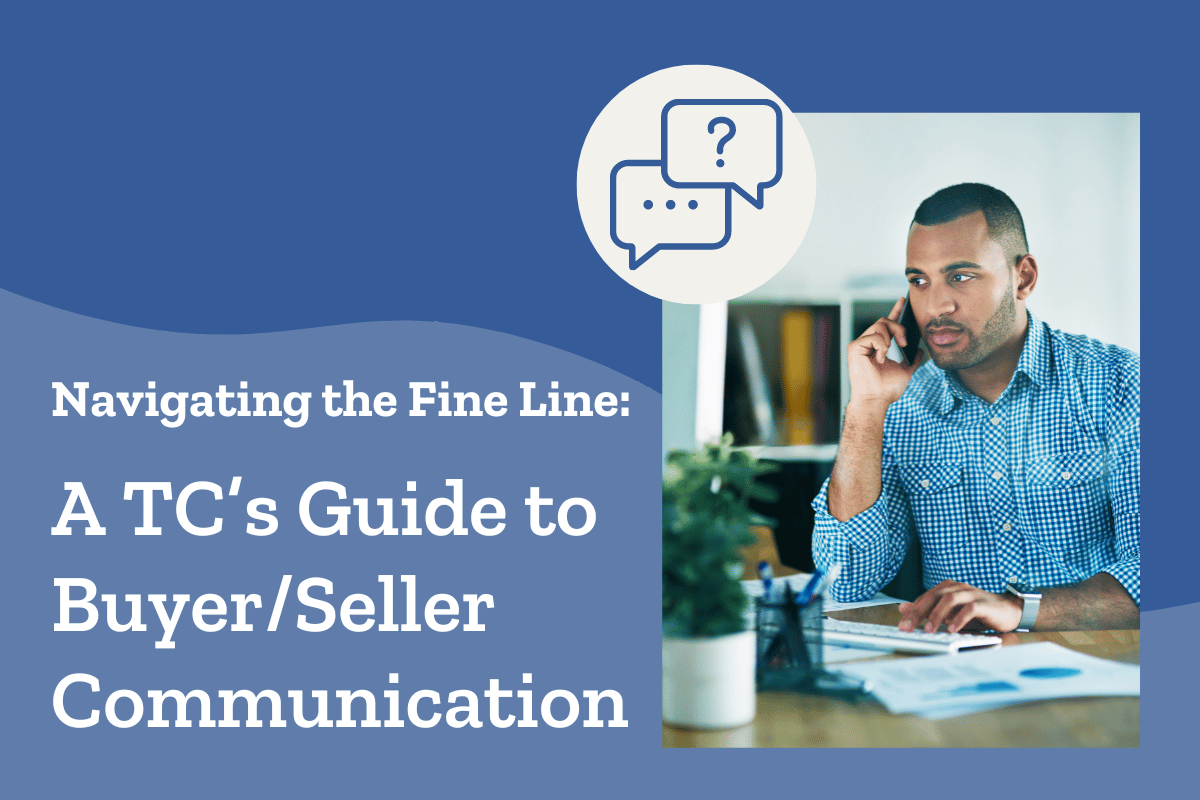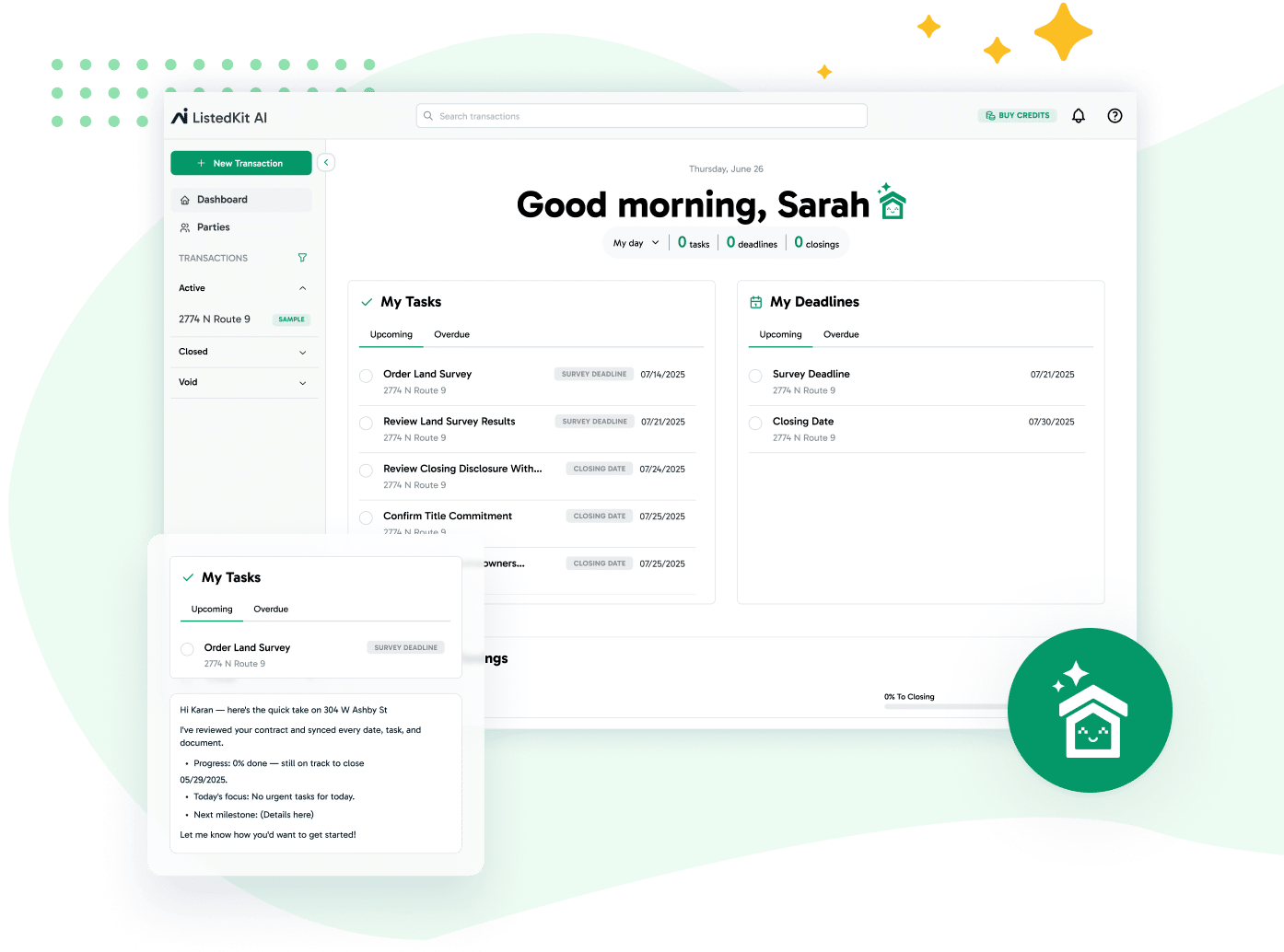Being a transaction coordinator (TC) is all about blending communication with boundaries. It’s a big part of what they do. In fact, 80% of a TC’s job is managing relationships and communication between all parties involved, while 20% is paperwork.
The challenge is to help without stepping into the shoes of the real estate agent.
Getting this balance right is important for professionalism and to avoid miscommunications and mistakes in the process.
Let’s dive in and look at some practical tips to walk this line so your role supports buyers and sellers while respecting the roles of real estate agents.
Your Role as a Transaction Coordinator
As a transaction coordinator (TC), you have a crucial role in keeping real estate transactions smooth and efficient. Your primary responsibilities are as follows:
- Paperwork Management: You prepare, organize and submit all necessary documents on time. This includes purchase agreements, addendums and disclosures.
- Stakeholder Coordination: You work with lenders, title companies, inspectors, property managers, real estate investors, and such to make sure everything is in sync. You schedule appointments, follow up on pending items and make sure everyone is on the same page.
- Client Interaction: Your role is to pass or relay information to buyers and sellers. Clients may ask for advice on contractual matters, but your job is to refer them back to their agents for guidance.
The Fine Line – What TCs Should and Shouldn’t Do
If you want to become a successful transaction coordinator in the real estate market, you’ll have to master the balance between providing help and not overstepping to the role of your real estate agents. Knowing what you should and shouldn’t do is key to being professional and efficient.
What You Should Do as a TC
- Provide proactive updates on the next steps, upcoming deadlines and missing documents. This keeps everyone on track and avoids last-minute panics.
- Guide clients on using transaction software. For instance, check if documents are signed in systems like ListedKit. This makes it easier for clients to proceed quickly with the transaction.
- When needed, redistribute important documents to lenders, escrow departments, and other parties. This will allow everyone to be on the same page and have the materials they need.
- Keep detailed records of all communications and document completions. This helps prevent misunderstandings and provides a clear trail of what has been done.
What You Shouldn’t Do as a TC
- Don’t advise on contract terms or summarize contracts. This is for the real estate agents to do as they have the legal knowledge and liability.
- Don’t give opinions on property conditions or other matters that require professional judgment. For example, don’t comment on a commercial property’s investment potential. That’s the real estate negotiator’s job.
- Never give professional advice that falls under the responsibilities of a real estate license professional. Only the agents should advise clients on market conditions or property values. No matter how knowledgeable you are about the subject, your role as a TC is to support, not to direct decisions.
Techniques for Establishing Trust Without Overstepping
To make sure that your clients and everyone who has a role in the process are on the same page as you and encourage a collaborative environment, here’s what you can do:
- Start with an introductory email or a Loom video. This personal touch allows clients and agents to put a face to your name, get to know you, and understand how you will help them from the very beginning.
- Use clear communication to set expectations and define your role from the start. Mention right away the scope of your work and also the tasks that are out of your control. This prevents misunderstandings and makes sure everyone knows what you do.
- Create a process. Make templates for common questions to save time and be clear. This makes your responses consistent and professional.
- Maintain communication standards. It’s also important to clarify your schedule. For instance, when do you send updates or reminders, when do you accept phone calls, and what’s the best time to contact you. Doing this will allow you and the other parties in the real estate sector to work more efficiently.
- Respect the client’s and agent’s time. Don’t communicate after hours unless necessary, and always follow up during business hours.
- Less is more. Get to the point quickly and be brief in your messages to be professional.
Client Communication Challenges
As a transaction coordinator, navigating client communication can be tough, especially when it comes to boundaries. You have to handle these situations carefully to keep transactions smooth and maintain trust with everyone involved.
Maintaining Boundaries When Agents Lack Communication
You may face situations where clients go around their agents and contact you directly. This happens when clients feel their agents are not communicating enough.
Here’s what you can do:
- Redirect Clients: Politely tell clients their agent is their point of contact for those questions.
- Follow Up with Agents: When clients contact you directly, tell the agent so they can respond quickly.
Be professional, especially when clients are frustrated. Stay calm and respectful. Do your best to keep your tone neutral and professional.
It’s still important to acknowledge their concerns, empathize with them, and show that you understand what they’re feeling. But you should stand firm and reiterate your role limitations.
By handling these communication challenges well, you are contributing to smoother real estate journeys and better customer experience management.
Managing Clients’ Expectations About Response Times
You may also face clients who expect immediate responses, especially during critical stages of a transaction. Being responsive is important but equally important is managing those expectations so you can have a work-life balance and provide quality service.
- Communicate Response Times: Set your response times in your initial communication, e.g. within 24 hours on weekdays. This sets the expectation from the start.
- Use Automated Acknowledgements: Set up automated email responses to let clients know you’ve received their message and will get back to them within your timeframe. This reassures them without you having to respond immediately.
By proactively communicating and managing response time, you can reduce client frustration, maintain your boundaries, and ensure all parties are satisfied.
Using Technology for Better Communication
Now that we’ve covered the importance of boundaries let’s talk about how technological advancements can help provide value and build strong relationships for real estate transaction coordinators.
Here are some examples:
AI Transaction Management
Transaction management allows you to process, organize, and review files faster through the use of artificial intelligence.
For instance, a tool like ListedKit scans your documents and pulls out the important bits in just a few minutes. You can also use it to keep and share important documents to real estate agents, sellers, and potential buyers.
Platforms like this can make managing multiple transactions more doable.
Smart Email Templates
Smart templates are a game-changer for speed and consistency. With templates that auto-populate with the latest transaction details, you can ensure every message is accurate and relevant.
They can give you a competitive edge in the real estate market, save time, help you communicate better, and build trust with clients and agents.
Task Management
Task management has a vital role in helping TCs stay organized. With a central dashboard for all your tasks, you can prioritize them and make sure you won’t miss anything.
This efficiency supports your role in the transaction process and helps you build strong relationships with real estate professionals and clients by meeting expectations.
Estate Virtual Tours
Virtual tours are a powerful way to show properties to potential buyers. These digital platforms save time for you and your clients by reducing the need for physical inspections.
Offering virtual tours makes the buying process easier and more fun. This not only builds trust with clients by giving them options but also shows you’re using the latest marketing tools to deliver the best service.
Social Media Platforms
Facebook and Instagram are marketing must-haves in the modern real estate industry.
By using these platforms for digital marketing, you can reach a wider audience through ads and organic posts.
Customer Relationship Management (CRM)
A good CRM tool with your real estate business can improve communication and relationship management by a lot.
A CRM stores all client interactions and information in one place, making follow-ups and ongoing communication seamless.
A complete view of all client interactions means you can deliver personalized service and not miss a thing. In a competitive real estate market a robust CRM is essential to stay ahead and fulfill your role in the transaction process.
Conclusion
As a TC, your communication skills are key to real estate transactions.
In a competitive market, you need to learn how to perfectly put yourself between supporting and respecting the boundaries of your role within the real estate agency.
Review and refine your communication processes regularly so you stay efficient and professional and keep transactions on track. Using tools like ListedKit can help you better manage these responsibilities. By setting and maintaining boundaries and improving your communication process, you’ll have long-term success and build strong relationships in real estate.




